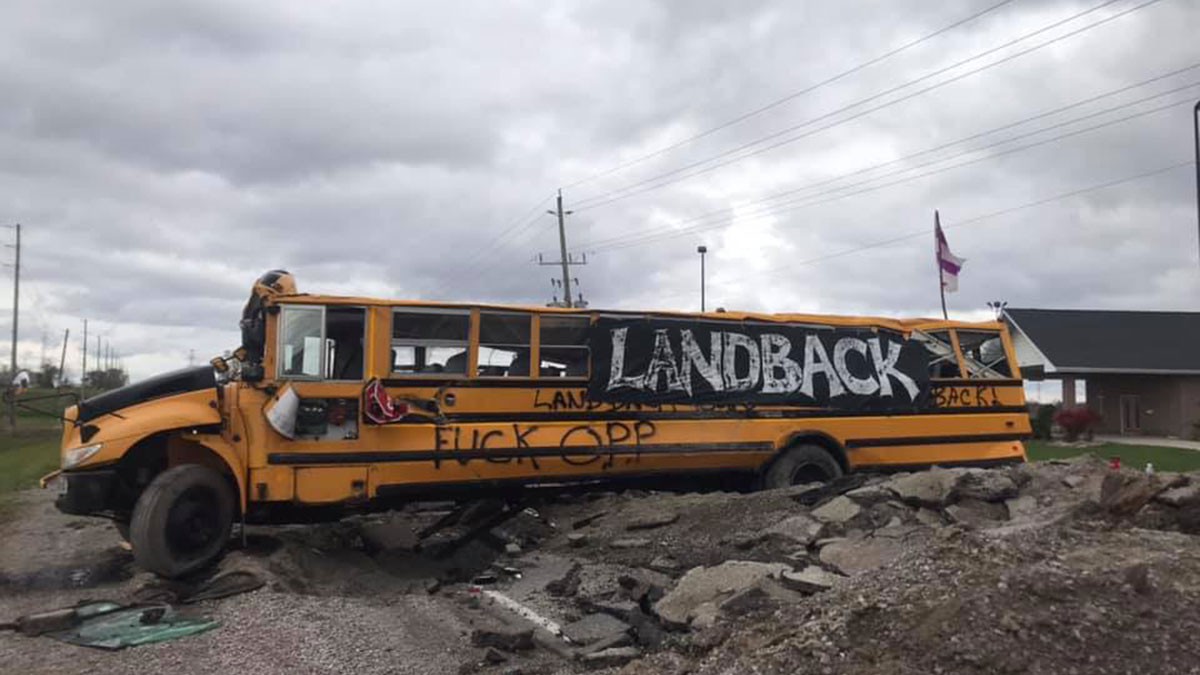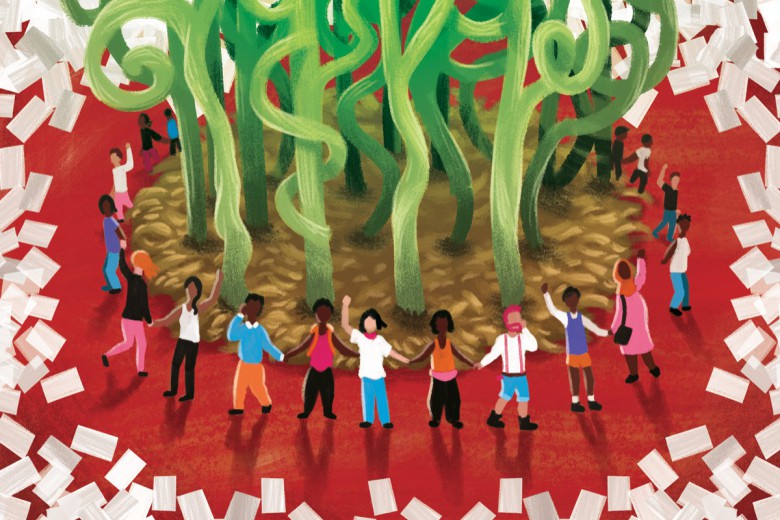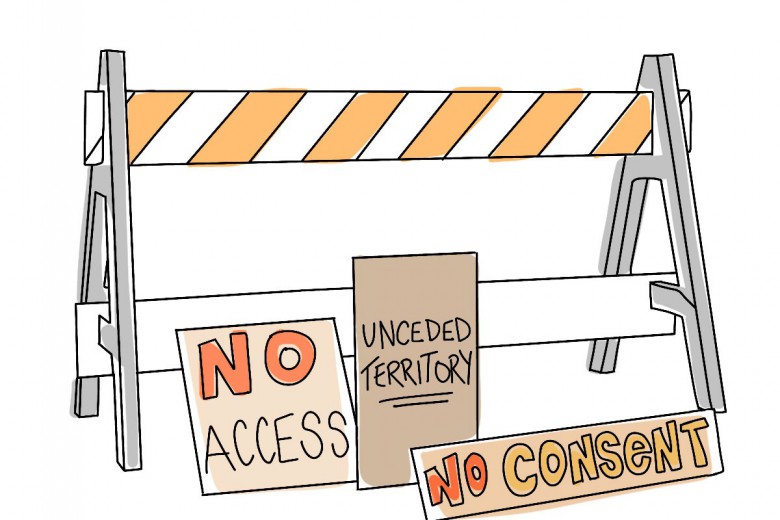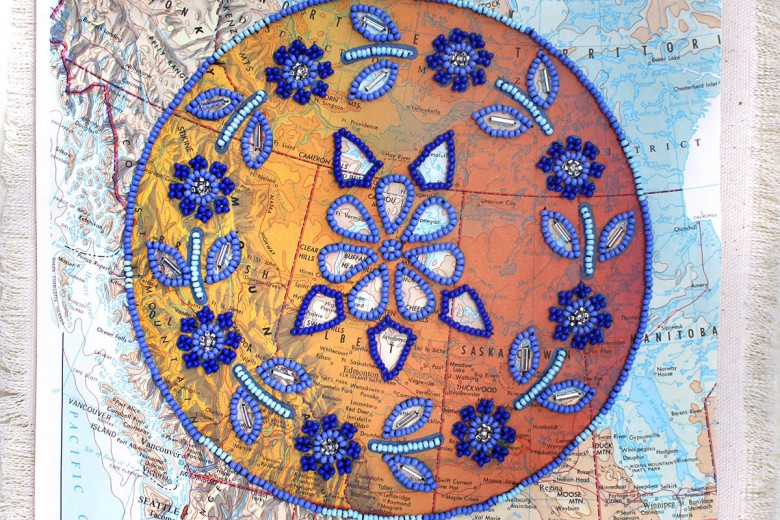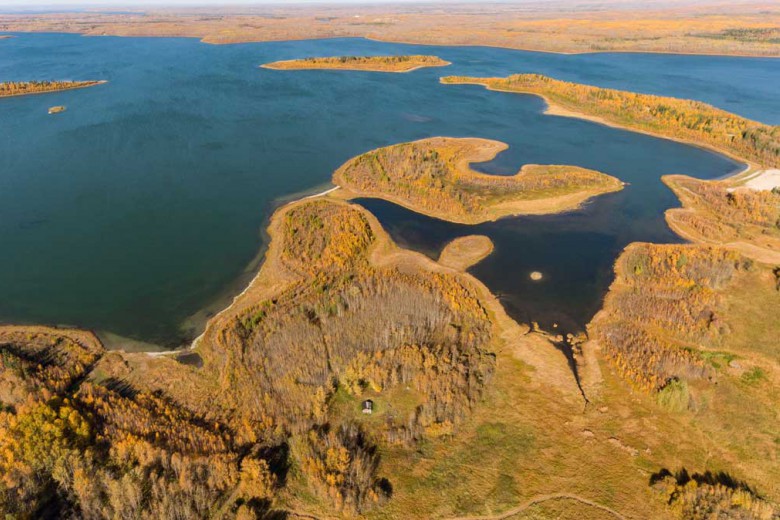We arrived at 1492 Land Back Lane just as the sun was setting, giving me only a brief glimpse of the full camp – the hill with Haudenosaunee flags flying; the land-back-mobile; the site across the road that was still green, unoccupied, and undeveloped; and the tents scattered across the land, with people weaving through them. I hadn’t seen so many people since before the quarantine, since the last occupation. Everything was dusty, and there were several fires lit across the camp, each surrounded by people laughing and enjoying themselves as the night gave them a moment’s rest from the working day. Someone was trying to make a water drum from some of the donated lumber, and in future rolling blockades those drums would be brought out to greet supporters that would arrive in droves to the camp.
There were all sorts – Elders, children, puppies – wandering about. Dim light illuminated the muddy puddles next to the lacrosse field. The site is Six Nations, and they are using it as they please, as they were promised by the Haldimand Treaty of 1784.
On July 19, when Six Nations land defenders first reclaimed McKenzie Road and renamed it 1492 Land Back lane, they were doing so in defense of that treaty. The treaty grants the Haudenosaunee six miles on either side of the Grand River – but in 2015, unceded Haudenosaunee land covered by that treaty was sold by Haldimand County to Foxgate Development. Foxgate began planning to build a housing development called McKenzie Meadows, the first part of a larger project that would extend all the way to the border of the neighbouring reserve, Six Nations of the Grand River.
The site is Six Nations, and they are using it as they please, as they were promised by the Haldimand Treaty of 1784.
Indigenous Peoples are one of the fastest growing populations in Canada, and Six Nations is the biggest First Nations reserve by population in Canada – but unlike settler communities, Six Nations’ growth is curtailed. The neighbouring town of Caledonia is a town of 9,600, while Six Nations’ on-reserve population is 12,800. Why is this site along Six Nations’ borders being sold to settler developers? McKenzie Meadows was hoping to build 218 units, while Six Nations is in dire need of 1,200 units to house their rapidly expanding population.
In 2019, the Six Nations’ elected chief and council signed an accommodation agreement with Foxgate, agreeing to “publicly support the proposed McKenzie Meadows housing development, not interfere with it, help quell any protests, and support property development company Foxgate in any legal actions brought by or against it,” APTN reports. In exchange, Foxgate gave the Six Nations Elected Council $325,000, 42 acres of land, and promised job opportunities for community members. Many community members feel that the chief and council don’t represent them – according to Six Nations land defender Skyler Williams, of the 27,000 community members eligible to vote in the last election, only 4 per cent did.
Holding their ground
For the past year or so, the country has been ignited from coast to coast with Indigenous resistance to resource extraction and land theft – it seems that every corner is home to some sort of Land Back movement or occupation. Each time the government, police, or individual settlers try to crush an action by violence, it only fans the flames of the movement. It happened at 1492 Land Back Lane, when hundreds of supporters poured into the camp following an Ontario Provincial Police (OPP) raid on August 5. That day, nine people were arrested after dozens of officers invaded the site, enforcing a temporary injunction. The arrestees were later released, but in response to the raid, land defenders set up roadblocks with burning tires, and shut down the Highway 6 bypass, part of Argyle Street, Sixth Line, and the train tracks that pass through Caledonia. The site was reoccupied after the raid.
On October 22, on the day that Foxgate and Haldimand County were granted a permanent injunction, police attacked the 6x6 peace camp on Sixth Line, using a taser and shooting rubber bullets near Elders and women while land defenders pushed back the OPP. Blockades went up again almost immediately. Using construction equipment, roads were ripped up and rendered impassable, preventing the OPP and anyone else from entering the site. The rail line running through Six Nations was dismantled, and a school bus was crushed into the middle of the road.
The arrestees were later released, but in response to the raid, land defenders set up roadblocks with burning tires, and shut down the Highway 6 bypass, part of Argyle Street, Sixth Line, and the train tracks that pass through Caledonia. The site was reoccupied after the raid.
With the blockades still standing, land defenders are cooperating with the OPP to the best of their ability while still holding their ground. The OPP, meanwhile, seem to be restraining themselves out of fear of sparking another cross-country solidarity movement like the rail blockades in support of Wet’suwet’en land defenders in February; Canada cannot afford another billion dollars in losses during the second wave of the COVID-19 pandemic. While they won’t say it aloud, it seems that the settler governments are aware of the power that Indigenous solidarity holds.
Over 125 days after Haudenosaunee land defenders began their occupation, tensions are still high and momentum is still strong. The OPP have followed supporters home as far as London, Ontario, to arrest all those they consider to have broken the injunction against the camp's presence. Over 30 land defenders have been arrested. Skyler Williams was ordered by an Ontario Superior Court Justice to pay $168,000 in legal bills for the developer and the municipality.
Now, with weather growing colder by the day, the Haudenosaunee are certain they will remain through the winter, ardent in their defense of the land promised to them by a treaty that made Six Nations a reserve in the first place.
Defend the treaties
Down the hill from one of the first 1492 Land Back Lane roadblocks is Kanonstaton, which means "the protected place," the site of another land dispute that climaxed in 2006. Back then, the Canadian government had illegally sold the land to a developer, arguing it had been surrendered in 1842, and a subdivision was about to be constructed on the territory. In response, Haudenosaunee land defenders re-occupied the site, blocking roads and railway tracks. Walking down the hill to Kanonhstaton around 6 a.m., I saw the most impressive road block I’ve ever seen: smashed cars and trucks flipped over, with debris of all sorts piled up. Right next to this blockade were the gates shaped like the Hiawatha Belt (the national belt of the Haudenosaunee) that mark the entry to Kanonhstaton. The conflict is still fresh, despite it being over a decade ago. The trial for the lawsuit that Six Nations brought against the federal and provincial governments in 1995 over the developers' purchase of the land is scheduled to begin in October 2022. The persistent organizing and labour of the Haudenosaunee land defenders is astonishing to witness.
There is little left for the people of the Haudenosaunee Confederacy to do other than to disrupt the settler-colonial status quo. The people I met at the camp were not politicians or policymakers; these were everyday working people, mothers and fathers, children, cousins, and grandparents, who were ignored for too long by the Indian Act-appointed chief and council. The traditional, hereditary governance of the Confederacy has been circumvented, despite Hereditary Chiefs’ legal right to negotiate land claims. The Haudenosaunee are not listened to on Parliament Hill, in Nathan Phillips Square, in the Caledonia city council, or any other place that the settler government reigns. There is no other option for Indigenous Peoples but disruption; only when the apolitical or ignorant settler is inconvenienced will he pay attention.
What Canada and the rest of the world must understand is that 1492 Land Back Lane does not exist only at the McKenzie Meadows site – it exists everywhere that Indigenous Nations rise against the power that oppresses, robs, and mistreats them.
After observing the past year of rail and road blockades, and the solidarity displayed between different Indigenous Nations defending their land, it’s clear to me: when we fight for one treaty, we fight for them all. When we fight for one Indigenous Nation, we fight for them all. We already know that Canada allies with other colonial powers to oppress Indigenous Peoples around the world – last year, Canada supported a military coup that ousted Bolivia’s first Indigenous president, Evo Morales, and replaced him with a Christian fundamentalist. The powers that oppress us benefit from the oppression of others just like us. What Canada and the rest of the world must understand is that 1492 Land Back Lane does not exist only at the McKenzie Meadows site – it exists everywhere that Indigenous Nations rise against the power that oppresses, robs, and mistreats them.
There has been an outpouring of solidarity as Land Back actions continue to spring up across so-called Canada. With the Wet’suwet’en Nation’s ongoing fight against the Coastal GasLink pipeline, the Mi’kmaq lobster dispute, the eviction of the Pekiwewin prayer camp, the moratorium on moose hunting in Anishinaabe territory, the list grows by the month. Solidarity is one of the few things we have left as Indigenous Nations, and as oppressed peoples in general. When we use this solidarity to build anti-colonial and socialist movements throughout all levels of society, we can win.
The future is uncertain, but the people are steadfast – the Haudenosaunee refuse to budge despite a permanent injunction on the site. This is about more than just a housing development. Six Nations has a treaty they must protect, and the precedent set by every broken treaty affects us all.
1492 Land Back Lane epitomizes what Land Back is really all about: Indigenous Peoples literally taking the land back; using the land in accordance with Indigenous Knowledge; and asserting their jurisdiction and Treaty Rights on the land. 1492 Land Back Lane may be raided again any day now, but 1492 Land Back Lane exists wherever Indigenous insurgency rises. Land Back is a ripple, and Canada should take heed of the coming waves.
Donate to the 1492 Land Back Lane legal fund for land defenders who have been arrested: https://ca.gofundme.com/f/legal-fund-1492-land-back-lane


